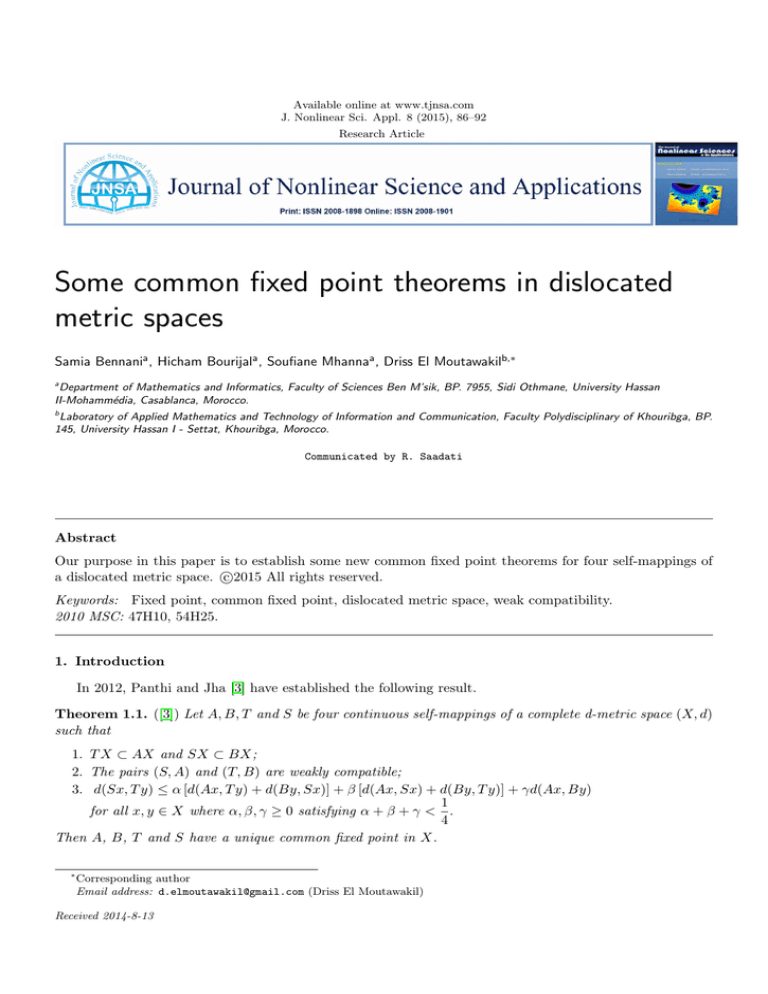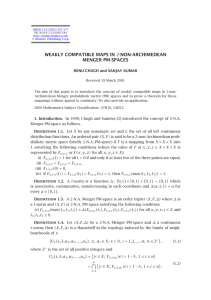
Available online at www.tjnsa.com
J. Nonlinear Sci. Appl. 8 (2015), 86–92
Research Article
Some common fixed point theorems in dislocated
metric spaces
Samia Bennania , Hicham Bourijala , Soufiane Mhannaa , Driss El Moutawakilb,∗
a
Department of Mathematics and Informatics, Faculty of Sciences Ben M’sik, BP. 7955, Sidi Othmane, University Hassan
II-Mohammédia, Casablanca, Morocco.
b
Laboratory of Applied Mathematics and Technology of Information and Communication, Faculty Polydisciplinary of Khouribga, BP.
145, University Hassan I - Settat, Khouribga, Morocco.
Communicated by R. Saadati
Abstract
Our purpose in this paper is to establish some new common fixed point theorems for four self-mappings of
c
a dislocated metric space. 2015
All rights reserved.
Keywords: Fixed point, common fixed point, dislocated metric space, weak compatibility.
2010 MSC: 47H10, 54H25.
1. Introduction
In 2012, Panthi and Jha [3] have established the following result.
Theorem 1.1. ([3]) Let A, B, T and S be four continuous self-mappings of a complete d-metric space (X, d)
such that
1. T X ⊂ AX and SX ⊂ BX;
2. The pairs (S, A) and (T, B) are weakly compatible;
3. d(Sx, T y) ≤ α [d(Ax, T y) + d(By, Sx)] + β [d(Ax, Sx) + d(By, T y)] + γd(Ax, By)
1
for all x, y ∈ X where α, β, γ ≥ 0 satisfying α + β + γ < .
4
Then A, B, T and S have a unique common fixed point in X.
∗
Corresponding author
Email address: d.elmoutawakil@gmail.com (Driss El Moutawakil)
Received 2014-8-13
S. Bennani, H. Bourijal, S. Mhanna, D. El Moutawakil, J. Nonlinear Sci. Appl. 8 (2015), 86–92
87
Our purpose, here, is to prove that this theorem can be improved without any continuity requirement.
1
Further, we will point out that if one supposes that γ > 0, then one can replace condition α + β + γ < by
4
1
α + β + γ ≤ . Recall that the notion of dislocated metric, introduced in 2000 by Hitzler and Seda [1], is
4
characterized by the fact that self distance of a point need not be equal to zero and has useful applications
in topology, logical programming and in electronics engineering. For further details on dislocated metric
spaces, see, for example [2, 4]. We begin by recalling some basic concepts of the theory of dislocated metric
spaces.
Definition 1.2. Let X be a non empty set and let d : X × X → [0, ∞) be a function satisfying the following
conditions
1. d(x, y) = d(y, x)
2. d(x, y) = d(y, x) = 0 implies x = y
3. d(x, y) = d(x, z) + d(z, y) forall x, y, z ∈ X.
Then d is called dislocated metric(or simply d-metric) on X.
Definition 1.3. A sequence (xn ) in a d-metric space (X, d) is called a Cauchy sequence if for given > 0,
there exists n0 ∈ N such that for all m, n ≥ n0 , we have d(xm , xn ) < .
Definition 1.4. A sequence in a d-metric space converges if there exists x ∈ X such that d(xn , x) → 0.
Definition 1.5. A d-metric space (X, d) is called complete if every Cauchy sequence is convergent.
Remark 1.6. It is easy to verify that in a dislocated metric space, we have the following technical properties:
• A subsequence of a Cauchy sequence in d-metric space is a Cauchy sequence.
• A Cauchy sequence in d-metric space which possesses a convergent subsequence, converges.
• Limits in a d-metric space are unique.
Definition 1.7. Let A and S be two self-mappings of a d-metric space (X, d).
A and S are said to be weakly compatible if they commute at their coincident point; that is, Ax = Sx for
some x ∈ X implies ASx = SAx.
2. Main results
Theorem 2.1. Let A, B, T and S be four self-mappings of a d-metric space (X, d) such that
1. T X ⊂ AX and SX ⊂ BX;
2. The pairs (S, A) and (T, B) are weakly compatible;
1
3. For all x, y ∈ X and α, β, γ ≥ 0 satisfying α + β + γ < , we have
4
d(Sx, T y) ≤ α [d(Ax, T y) + d(By, Sx)] + β [d(Ax, Sx) + d(By, T y)] + γd(Ax, By);
4. The range of one of the mappings A, B, S or T is a complete subspace of X.
Then A, B, T and S have a unique common fixed point in X.
(2.1)
S. Bennani, H. Bourijal, S. Mhanna, D. El Moutawakil, J. Nonlinear Sci. Appl. 8 (2015), 86–92
88
Proof. Let x0 be an arbitrary point in X. Choose x1 ∈ X such that Bx1 = Sx0 . Choose x2 ∈ X such that
Ax2 = T x1 . Continuing in this fashion, choose xn ∈ X such that Sx2n = Bx2n+1 and T x2n+1 = Ax2n+2 for
n = 0, 1, 2, .... To simplify, we consider the sequence (yn ) defined by y2n = Sx2n and y2n+1 = T x2n+1 for
n = 0, 1, 2, ....
We claim that (yn ) is a Cauchy sequence. Indeed, by using (2.1) for n ≥ 1, we have
d(y2n+1 , y2n ) =
≤
≤
≤
≤
d(Sx2n , T x2n+1 )
α [d(Ax2n , T x2n+1 ) + d(Bx2n+1 , Sx2n )]
+ β [d(Ax2n , Sx2n ) + d(Bx2n+1 , T x2n+1 )] + γd(Ax2n , Bx2n+1 )
α [d(y2n−1 , y2n+1 ) + d(y2n , y2n )]
+ β [d(y2n−1 , y2n ) + d(y2n , y2n+1 )] + γd(y2n−1 , y2n )
α [d(y2n−1 , y2n ) + d(y2n , y2n+1 ) + d(y2n , y2n+1 ) + d(y2n+1 , y2n )]
+ β [d(y2n−1 , y2n ) + d(y2n , y2n+1 )] + γd(y2n−1 , y2n )
(α + β + γ)d(y2n−1 , y2n ) + (3α + β)d(y2n , y2n+1 ).
Therefore
d(y2n , y2n+1 ) ≤ h d(y2n−1 , y2n )
α+β+γ
∈ [0, 1[. Hence (yn ) is a Cauchy sequence in X and therefore, according to Remarks
1 − 3α − β
1.1, (Sx2n ), (Bx2n+1 ), (T x2n+1 ) and (Ax2n+2 ) are also Cauchy sequence.
Suppose that SX is a complete subspace of X, then the sequence (Sx2n ) converges to some Sa such
that a ∈ X. According to Remark (1.6), (yn ), (Bx2n+1 ), (T x2n+1 ) and (Ax2n+2 ) converge to Sa. Since
SX ⊂ BX, there exists u ∈ X such that Sa = Bu. We show that Bu = T u. In fact, by using (2.1), we have
where h =
d(Sx2n , T u) ≤ α [d(Sx2n , T u) + d(Bu, Sx2n )] + β [d(Ax2n , Sx2n ) + d(Bu, T u)] + γd(Ax2n , Bu)
and therefore, on letting n to infty, we get
d(Bu, T u) ≤
≤
≤
≤
α [d(Bu, T u) + d(Bu, Bu)] + β [d(Bu, Bu) + d(Bu, T u)] + γd(Bu, Bu)
(α + β + γ) d(Bu, Bu) + (α + β) d(Bu, T u)
2 (α + β + γ) d(Bu, T u) + (α + β) d(Bu, T u)
(3α + 3β + 2γ) d(Bu, T u)
which implies that
(1 − 3α − 3β − 2γ) d(Bu, T u) ≤ 0
and therefore d(Bu, T u) = 0, since (1 − 3α − 3β − 2γ) < 0, which implies that T u = Bu. Since T X ⊂ AX,
there exists v ∈ X such that T u = Av. We show that Sv = Av. Indeed, by using (2.1), we have
d(Sv, Av) =
≤
≤
≤
≤
d(Sv, T u)
α [d(Av, T u) + d(Bu, Sv)] + β [d(Av, Sv) + d(Bu, T u)] + γd(Av, Bu)
α [d(Av, Av) + d(Av, Sv)] + β [d(Av, Sv) + d(Av, Av)] + γd(Av, Av)
α [d(Av, Sv) + d(Sv, Av) + d(Av, Sv)] + β [d(Av, Sv) + d(Av, Sv) + d(Sv, Av)]
+ γ [d(Av, Sv) + d(Sv, Av)]
(3α + 3β + 2γ) d(Av, Sv)
which implies that
(1 − 3α − 3β − 2γ) d(Av, Sv) ≤ 0
and therefore d(Av, Sv) = 0, since 1 − 3α − 3β − 2γ < 0, which implies that Av = Sv. Hence Bu = T u =
Av = Sv.
The weak compatibility of S and A implies that ASv = SAv, from which it follows that AAv = ASv =
S. Bennani, H. Bourijal, S. Mhanna, D. El Moutawakil, J. Nonlinear Sci. Appl. 8 (2015), 86–92
89
SAv = SSv.
The weak compatibility of B and T implies that BT u = T Bu, from which it follows that BBu = BT u =
T Bu = T T u.
Let us show that Bu is a fixed point of T . Indeed, from (2.1), we get
d(Bu, T Bu) =
≤
≤
≤
≤
d(Sv, T Bu)
α [d(Av, T Bu) + d(BBu, Sv)] + β [d(Av, Sv) + d(BBu, T Bu)] + γd(Av, BBu)
α [d(Bu, T Bu) + d(T Bu, Bu)] + β [d(Bu, Bu) + d(T Bu, T Bu)] + γd(Bu, T Bu)
2αd(Bu, T Bu) + β [d(Bu, T Bu) + d(T Bu, Bu) + d(T Bu, Bu) + d(Bu, T Bu)]
+ γd(Bu, T Bu)
(2α + 4β + γ) d(Bu, T Bu)
and therefore d(Bu, T Bu) = 0, since 1 − 2α − 4β − γ < 0, which implies that T Bu = Bu. Hence Bu is a
fixed point of T . It follows that BBu = T Bu = Bu, which implies that Bu is a fixed point of B.
On the other hand, in view of (2.1), we have
d(SBu, Bu) =
≤
≤
≤
≤
d(SBu, T Bu)
α [d(ABu, T Bu) + d(BBu, SBu)] + β [d(ABu, SBu) + d(BBu, T Bu)] + γd(ABu, BBu)
α [d(SBu, Bu) + d(Bu, SBu)] + β [d(Bu, Bu) + d(Bu, Bu)] + γd(Bu, Bu)
2αd(Bu, SBu) + β [d(Bu, SBu) + d(SBu, Bu) + d(Bu, SBu) + d(SBu, Bu)]
+ γ [d(Bu, SBu) + d(SBu, Bu)]
(2α + 4β + 2γ) d(Bu, SBu)
and therefore d(Bu, SBu) = 0, since 1 − 2α − 4β − 2γ < 0, which implies that SBu = Bu. Hence Bu is a
fixed point of S. It follows that ABu = SBu = Bu, which implies that Bu is also a fixed point of S. Thus
Bu is a common fixed point of S, T , A and B.
Finally to prove uniqueness, suppose that there exists u, v ∈ X such that Su = T u = Au = Bu and
Su = T u = Au = Bv. If d(u, v) 6= 0, then, by using (2.1), we get
d(u, v) =
≤
≤
≤
d(Su, T v)
α [d(Au, T v) + d(Bv, Su)] + β [d(Au, Su) + d(Bv, T v)] + γd(Au, Bv)
α [d(u, v) + d(u, v)] + β [d(u, u) + d(v, v)] + γd(u, v)
(2α + 4β + γ)d(u, v)
from which it follows that (1 − 2α − 4β − γ) d(u, v) ≤ 0 which is a contradiction since 1 − 2α − 4β − γ < 0.
Hence d(u, v) = 0 and therefore u = v.
The proof is similar when T X or AX or Bx is a complete subspace of X. This completes the proof.
For A = B and S = T in (2.1), we have the following result.
Corollary 2.2. Let (X, d) be a d-metric space. Let A and T be two self-mappings of X such that
1. T X ⊂ AX
2. The pair (T, A) is weakly compatible and
3. d(T x, T y) ≤ α [d(Ax, T y) + d(Ay, T x)] + β [d(Ax, T x) + d(Ay, T y)] + γd(Ax, Ay)
1
for all x, y ∈ X where α, β, γ ≥ 0 satisfying α + β + γ <
4
4. T X or AX is a complete subspace of X.
Then A and T have a unique common fixed point in X.
For A = B = IdX in (2.1), we get the following corollary.
Corollary 2.3. Let (X, d) be a d-metric space. Let T and S be two self-mappings of X such that
S. Bennani, H. Bourijal, S. Mhanna, D. El Moutawakil, J. Nonlinear Sci. Appl. 8 (2015), 86–92
90
1. d(Sx, T y) ≤ α [d(x, T y) + d(y, Sx)] + β [d(x, Sx) + d(y, T y)] + γd(x, y)
1
for all x, y ∈ X where α, β, γ ≥ 0 satisfying α + β + γ <
4
2. T X or SX is a complete subspace of X.
Then T and S have a unique common fixed point in X.
For S = T = IdX in (2.1), we have the following result.
Corollary 2.4. Let (X, d) be a complete d-metric space. Let A and B be two surjective self-mappings of X
such that
d(x, y) ≤ α [d(Ax, y) + d(By, x)] + β [d(Ax, x) + d(By, y)] + γd(Ax, By)
1
for all x, y ∈ X where α, β, γ ≥ 0 satisfying α + β + γ < . Then A and B have a unique common fixed
4
point in X.
Remark 2.5. Following the procedure used in the proof of Theorem in 2.1, we have the next new result in
1
1
which we replace the condition α + β + γ < by α + β + γ ≤
4
4
Theorem 2.6. Let A, B, T and S be four self-mappings of a d-metric space (X, d) such that
1. T X ⊂ AX and SX ⊂ BX
2. The pairs (S, A) and (T, B) are weakly compatible and
1
3. For all x, y ∈ X, α, β ≥ 0 and γ > 0 satisfying α + β + γ ≥ , we have
4
d(Sx, T y) ≤ α [d(Ax, T y) + d(By, Sx)] + β [d(Ax, Sx) + d(By, T y)] + γd(Ax, By)
(2.2)
4. The range of one of the mappings A, B, S or T is a complete subspace of X.
Then A, B, T and S have a unique common fixed point in X.
1
Proof. For α, β ≥ 0 and γ > 0 satisfying α + β + γ < , we apply Theorem 2.1. For α, β ≥ 0 and γ > 0
4
1
satisfying α + β + γ = , we consider, as in Theorem 2.1, an arbitrary point x0 in X and the sequence
4
(xn ) defined in X by Sx2n = Bx2n+1 and T x2n+1 = Ax2n+2 for n = 0, 1, 2, .... To simplify, we consider the
sequence (yn ) defined by y2n = Sx2n and y2n+1 = T x2n+1 for n = 0, 1, 2, ....
We claim that (yn ) is a Cauchy sequence. Indeed, by using (2.2) for n ≥ 1, we have
d(y2n+1 , y2n ) =
≤
≤
≤
≤
≤
d(Sx2n , T x2n+1 )
α [d(Ax2n , T x2n+1 ) + d(Bx2n+1 , Sx2n )]
+ β [d(Ax2n , Sx2n ) + d(Bx2n+1 , T x2n+1 )] + γd(Ax2n , Bx2n+1 )
α [d(y2n−1 , y2n+1 ) + d(y2n , y2n )]
+ β [d(y2n−1 , y2n ) + d(y2n , y2n+1 )] + γd(y2n−1 , y2n )
α [d(y2n−1 , y2n ) + d(y2n , y2n+1 ) + d(y2n , y2n+1 ) + d(y2n+1 , y2n )]
+ β [d(y2n−1 , y2n ) + d(y2n , y2n+1 )] + γd(y2n−1 , y2n )
(α + β + γ)d(y2n−1 , y2n ) + (3α + β)d(y2n , y2n+1 )
1
d(y2n−1 , y2n ) + (3α + β)d(y2n , y2n+1 ).
4
1
∈ [0, 1[. Hence (yn ) is a Cauchy
4(1 − 3α − β)
sequence in X and therefore, according to Remarks 1.1, (Sx2n ), (Bx2n+1 ), (T x2n+1 ) and (Ax2n+2 ) are also
Cauchy sequence.
Suppose that SX is a complete subspace of X, then the sequence (Sx2n ) converges to some Sa such
Therefore d(y2n , y2n+1 ) ≤ h d(y2n−1 , y2n ), where h =
S. Bennani, H. Bourijal, S. Mhanna, D. El Moutawakil, J. Nonlinear Sci. Appl. 8 (2015), 86–92
91
that a ∈ X. According to Remark (1.6), (yn ), (Bx2n+1 ), (T x2n+1 ) and (Ax2n+2 ) converge to Sa. Since
SX ⊂ BX, there exists u ∈ X such that Sa = Bu. We show that Bu = T u. In fact, in view of by using
(2.1), we have
d(Sx2n , T u) ≤ α [d(Sx2n , T u) + d(Bu, Sx2n )] + β [d(Ax2n , Sx2n ) + d(Bu, T u)] + γd(Ax2n , Bu)
and therefore, on letting n to infty, we get
d(Bu, T u) ≤
≤
≤
≤
α [d(Bu, T u) + d(Bu, Bu)] + β [d(Bu, Bu) + d(Bu, T u)] + γd(Bu, Bu)
(α + β + γ) d(Bu, Bu) + (α + β) d(Bu, T u)
2 (α + β + γ) d(Bu, T u) + (α + β) d(Bu, T u)
(3α
+ 3β
+ 2γ) d(Bu, T u)
3
≤
− γ d(Bu, T u)
4
1
which implies that ( + γ) d(Bu, T u) ≤ 0. Therefore d(Bu, T u) = 0, which implies that T u = Bu. Since
4
T X ⊂ AX, there exists v ∈ X such that T u = Av. We show that Sv = Av. In fact, by using (2.2), we have
d(Sv, Av) =
≤
≤
≤
d(Sv, T u)
α [d(Av, T u) + d(Bu, Sv)] + β [d(Av, Sv) + d(Bu, T u)] + γd(Av, Bu)
α [d(Av, Av) + d(Av, Sv)] + β [d(Av, Sv) + d(Av, Av)] + γd(Av, Av)
α [d(Av, Sv) + d(Sv, Av) + d(Av, Sv)] + β [d(Av, Sv) + d(Av, Sv) + d(Sv, Av)]
+ γ [d(Av, Sv) + d(Sv, Av)]
(3α
+ 3β
+ 2γ) d(Av, Sv)
3
− γ d(Av, Sv)
4
≤
≤
1
which implies that ( + γ) d(Av, Sv) ≤ 0. Therefore d(Av, Sv) = 0, which implies that Av = Sv. Hence
4
Bu = T u = Av = Sv.
The weak compatibility of S and A implies that ASv = SAv, from which it follows that AAv = ASv =
SAv = SSv.
The weak compatibility of B and T implies that BT u = T Bu, from which it follows that BBu = BT u =
T Bu = T T u.
Let us show that Bu is a fixed point of T . Indeed, by using (2.2), we have
d(Bu, T Bu) =
≤
≤
≤
≤
d(Sv, T Bu)
α [d(Av, T Bu) + d(BBu, Sv)] + β [d(Av, Sv) + d(BBu, T Bu)] + γd(Av, BBu)
α [d(Bu, T Bu) + d(T Bu, Bu)] + β [d(Bu, Bu) + d(T Bu, T Bu)] + γd(Bu, T Bu)
2αd(Bu, T Bu) + β [d(Bu, T Bu) + d(T Bu, Bu) + d(T Bu, Bu) + d(Bu, T Bu)]
+ γd(Bu, T Bu)
(2α + 4β + γ) d(Bu, T Bu)
1
and therefore d(Bu, T Bu) = 0, since 1 − 2α − 4β − γ ≥ 1 − 4( − γ) − γ = 3γ > 0, which implies that
4
T Bu = Bu. Hence Bu is a fixed point of T . It follows that BBu = T Bu = Bu, which implies that Bu is a
fixed point of B.
On the other hand, by using (2.2), we have
d(SBu, Bu) =
≤
≤
≤
≤
d(SBu, T Bu)
α [d(ABu, T Bu) + d(BBu, SBu)] + β [d(ABu, SBu) + d(BBu, T Bu)] + γd(ABu, BBu)
α [d(SBu, Bu) + d(Bu, SBu)] + β [d(Bu, Bu) + d(Bu, Bu)] + γd(Bu, Bu)
2αd(Bu, SBu) + β [d(Bu, SBu) + d(SBu, Bu) + d(Bu, SBu) + d(SBu, Bu)]
+ γ [d(Bu, SBu) + d(SBu, Bu)]
(2α + 4β + 2γ) d(Bu, SBu)
S. Bennani, H. Bourijal, S. Mhanna, D. El Moutawakil, J. Nonlinear Sci. Appl. 8 (2015), 86–92
92
1
and therefore d(Bu, SBu) = 0, since 1 − 2α − 4β − 2γ ≥ 1 − 4( − γ) − 2γ = 2γ > 0, which implies that
4
SBu = Bu. Hence Bu is a fixed point of S. It follows that ABu = SBu = Bu, which implies that Bu is
also a fixed point of S. Thus Bu is a common fixed point of S, T , A and B.
Finally to prove uniqueness, suppose that there exists u, v ∈ X such that Su = T u = Au = Bu and
Su = T u = Au = Bv. If d(u, v) 6= 0, then by using (2.2), we get
d(u, v) =
≤
≤
≤
d(Su, T v)
α [d(Au, T v) + d(Bv, Su)] + β [d(Au, Su) + d(Bv, T v)] + γd(Au, Bv)
α [d(u, v) + d(u, v)] + β [d(u, u) + d(v, v)] + γd(u, v)
(2α + 4β + γ)d(u, v)
from which it follows that (1 − 2α − 4β − γ) d(u, v) ≤ 0 which is a contradiction since 1 − 2α − 4β − γ < 0.
Hence d(u, v) = 0 and therefore u = v.
The proof is similar when T X or AX or Bx is a complete subspace of X. This completes the proof.
For A = B and S = T in (2.6), we have the following result.
Corollary 2.7. Let (X, d) be a d-metric space. Let A and T be two self-mappings of X such that
1. T X ⊂ AX
2. The pair (T, A) is weakly compatible and
3. d(T x, T y) ≤ α [d(Ax, T y) + d(Ay, T x)] + β [d(Ax, T x) + d(Ay, T y)] + γd(Ax, Ay)
1
for all x, y ∈ X where α, β ≥ 0 and γ > 0 satisfying α + β + γ ≤
4
4. T X or AX is a complete subspace of X.
Then A and T have a unique common fixed point in X.
For A = B = IdX in (2.6), we get the following corollary.
Corollary 2.8. Let (X, d) be a d-metric space. Let T and S be two self-mappings of X such that
1. d(Sx, T y) ≤ α [d(x, T y) + d(y, Sx)] + β [d(x, Sx) + d(y, T y)] + γd(x, y)
1
for all x, y ∈ X where α, β ≥ 0 and γ > 0 satisfying α + β + γ ≤
4
2. T X or SX is a complete subspace of X.
Then T and S have a unique common fixed point in X.
For S = T = IdX in (2.6), we have the following result.
Corollary 2.9. Let (X, d) be a complete d-metric space. Let A and B be two surjective self-mappings of X
such that
d(x, y) ≤ α [d(Ax, y) + d(By, x)] + β [d(Ax, x) + d(By, y)] + γd(Ax, By)
1
for all x, y ∈ X where α, β ≥ 0 and γ > 0 satisfying α + β + γ ≤ . Then A and B have a unique common
4
fixed point in X.
References
[1] P. Hitzler, A. K. Seda, Dislocated Topologies, J. Electrical Engineering, 51 (2000), 3–7. 1
[2] P. Hitzler, Generalized metrices and topology in logic programming semantics, Ph. D. Thesis, National University
of Ireland, (University College, Cork), (2001). 1
[3] D. Panthi, K. Jha, A common fixed point of weakly compatible mappings in dislocated metric space, Kathmandu
University J. Sci., Engineering and Technology, 8 (2012), 25–30. 1, 1.1
[4] I. Rambhadra Sarma, P. Sumati Kumari, On dislocated metric spaces, Int. J. Math. Archive, 3 (2012), 72–77. 1





![(M.P.) Dong-A [11] MAPPINGS](http://s2.studylib.net/store/data/010441581_1-a70e3460008654b4bbba2d64e1b9ccd1-300x300.png)





